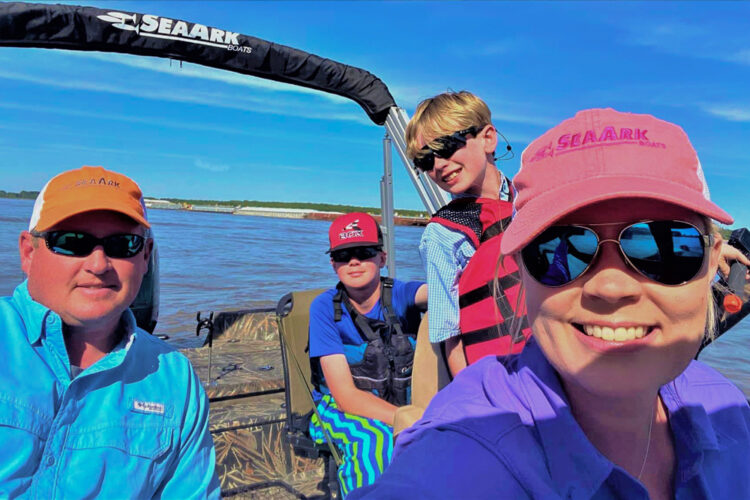Roy and Holly Sweat Harkness practice water safety beginning with life jackets on the kids.
They are shown here with their sons on a fishing adventure. Hunter is 15 years old and Luke is 11.
Teach Kids to be Safe on the Water
As more young anglers hit the water to fish for fun or even to fish tournaments with their parents, safe boating habits cannot be ignored.
Any given weekend it is easy to find catfish boats with children on board. It is also easy to browse social media and find proud parents posting photos of their kids having fun fishing. Accompanying that trend is a need for emphasizing boater safety for kids.
Kids are fast learners and if given proper instruction they can develop safety awareness that will last them for their lifetime. There are some great guidelines on the SafeKids Worldwide website where their mission is to prevent childhood injuries. They offer some great common sense things to teach kids that will help them be safe on the water.

Life Jackets
One of the most important things for water safety is a U.S. Coast Guard-approved life jacket (PFD). Guardians should choose a life jacket that is right for the child’s weight and water activity. For younger children, choose a PFD with both a collar for head support and a strap between the legs.
A good-fitting life jacket can prevent injury or worse while boating, swimming, tubing, or engaging in other water recreation.
Teach Your Child to Swim
The next common sense option for water safety among kids is to teach them how to swim. To begin with, the SafeKids website suggests teaching kids the difference between swimming in a pool and swimming in open water. Their website notes, “Be aware of situations that are unique to open water, such as limited visibility, depth, uneven surfaces, currents, and undertow. These potential hazards can make swimming in open water more challenging than swimming in a pool.”
The best option is to enroll the kids in swimming lessons with a professional teacher. Beyond that, the SafeKids Worldwide site offers five water survival skills for kids (these same skills are good for adults too).
- Step or jump into water over their head and return to the surface. This skill will make them more comfortable in the water and help them respond to accidents that can leave them overboard.
- Turn around in the water and orient to safety. Learning to do this will add more confidence to being in the water and improve their chances of responding quickly when needed.
- Float or tread water. If kids can float or tread water it gives more time for a bystander to retrieve and comfort the kids.
- Combine breathing with forward movement in the water. This skill gives them the ability to spend more time in the water for someone to come to the rescue.
- Exit the water. Practicing exiting the water under different conditions prepares them to find safety quicker. Climbing a boarding ladder on a vessel or dock is different than grabbing brush or a tree limb in a flowing river. The more confidence they have in the water the more successful the exit.
Learning these five skills will allow your kids to anticipate, avoid, and survive common drowning situations that may arise. The way they respond to an accident can be the difference between a happy ending to the day and tragedy.
To consider more water safety and rescue skills visit the website at Water Safety USA.



